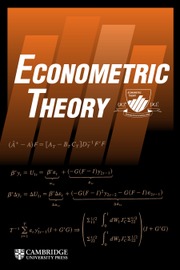No CrossRef data available.
Article contents
AVERAGING ESTIMATORS OF HETEROGENEOUS TREATMENT EFFECTS UNDER ADDITIVE MODELS
Published online by Cambridge University Press: 22 October 2025
Abstract
We consider spline-based additive models for estimation of conditional treatment effects. To handle the uncertainty due to variable selection, we propose a method of model averaging with weights obtained by minimizing a J-fold cross-validation criterion, in which a nearest neighbor matching is used to approximate the unobserved potential outcomes. We show that the proposed method is asymptotically optimal in the sense of achieving the lowest possible squared loss in some settings and assigning all weight to the correctly specified models if such models exist in the candidate set. Moreover, consistency properties of the optimal weights and model averaging estimators are established. A simulation study and an empirical example demonstrate the superiority of the proposed estimator over other methods.
Information
- Type
- ARTICLES
- Information
- Copyright
- © The Author(s), 2025. Published by Cambridge University Press
Footnotes
The authors are very grateful to the editor, associate editor, and two anonymous referees for their constructive comments and suggestions. X.Z.’s work is supported by the National Key Research and Development Program of China (Grant No. 2023YFA1008704) and the National Natural Science Foundation of China (Grant Nos. 72525001 and 72495124). Y.F.’s work is supported by the National Natural Science Foundation of China (Grant No. 12561051) and Yunnan Province XingDian Talent Support Program (Grant No. YNWR-YLXZ-2018-020).

